Posted by Anita on 01.11.08 4:30 PM
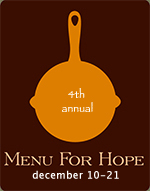 Oh, boy! The winners of the Menu for Hope raffle have been announced. Check out Pim’s giant list of all the winners to see what you won.
Oh, boy! The winners of the Menu for Hope raffle have been announced. Check out Pim’s giant list of all the winners to see what you won.
I’m tickled pink that local food-and-spirits maven Jane Tunks won our custom mixology service prize — we’ll be bringing Drink of the Week to Jane’s house sometime soon, mixing up a pair of signature cocktails for a dozen of her swellest pals.
And our blog-buddy Lara, one of the blogosphere’s all-time most-fabulous food photographers, won the Drink of the Week notecards on the same month she picked beverages as her Still Life With… challenge theme. Spooky, eh?
Lest you think we fixed all of the results, I’m relieved to announce that a total stranger — Lauren Kawakami — won our “Best of the Ferry Building” basket. (Ms. K, if you’re out there, please drop a note to chef -at- marriedwithdinner -dot- com, with your mailing address, and we’ll get your prize in the post ASAP.)
Can you believe we raised $91,188 for the UN World Food Programme? That’s an astounding success! Thank you, again, to everyone who participated in the raffle. I can’t wait to see what next year’s Menu for Hope has in store.
Menu for Hope
Comments Off on Win-win-win scenario




Posted by Anita on 01.11.08 7:48 AM
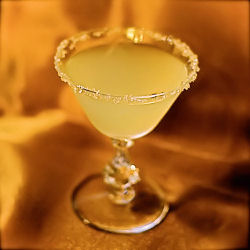 Invented in France during the years of America’s “noble experiment” with Prohibition, it’s puzzling that the Sidecar has yet to take its proper place in the modern cocktail renaissance. It’s a glorious drink when well made, but it does subject the bartender to a little bit of fuss.
Invented in France during the years of America’s “noble experiment” with Prohibition, it’s puzzling that the Sidecar has yet to take its proper place in the modern cocktail renaissance. It’s a glorious drink when well made, but it does subject the bartender to a little bit of fuss.
As with many simple drinks, the quality of the ingredients can make or break this recipe; Robert Hess does an excellent job detailing the contributions of the various components. But even when using top-shelf brands, you’ll need to do a fair bit of balancing. Brandies vary widely in strength and sweetness, and even plain-old Eureka lemons change in acidity throughout the growing season.
The traditional recipe of equal parts brandy, triple-sec, and lemon juice is very sweet, especially when served in the customary sugar-rimmed glass. Although I won’t go as far as David Embury — who rationalized that a Sidecar is simply a Daiquiri clone, and advocated a bone-dry ratio of 7:2:1 — I do think that all but the sweetest palates will prefer something closer to two parts brandy to one part each Cointreau and juice.
Like many old-time recipes, the Sidecar has undergone a dizzying list of modifications over the past 70 years. Beyond modernizing the proportions, this recipe stands up to a fair bit of tinkering. Varying the base liquor gets you a Chelsea Sidecar (gin), a Boston Sidecar (rum plus brandy), or an Applecar (Applejack). Swapping lime juice for the lemon, or tweaking Cointreau for another liqueur yields even more alternatives.

For this month’s Mixology Monday — a Brandy theme, hosted by the lovely Marleigh at over at Sloshed! — we took our inspiration from a drink we enjoyed at Cindy’s Backstreet Kitchen. The menu listed Belle de Brillet pear Cognac in place of the brandy (and you know we loves us some of that). Alas, the resulting mixture was jaw-numbingly sweet, but the concept was just too good to ignore; off we went to the home laboratory.
First we tried decreasing the sweet components: Reducing the Belle de Brillet diminished the beautiful pear essence of the drink, and halving the Cointreau flattened everything out. Starting out from the other direction, increasing the lemon juice made things too puckery. Dispensing with the sugared rim did help a bit, but it seems a shame to lose this sparkle.
At last, we turned to the Clear Creek Pear Brandy (or, better still, its sibling eau de vie in the captive-pear bottle). Hooray! We’d found plenty of pear and fruity warmth without the cloying sweetness.
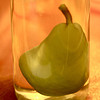

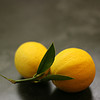
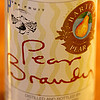
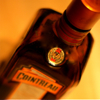

Le Side-car aux Poires
1-1/2 oz pear brandy
3/4 oz Cointreau
3/4 oz lemon juice
Before squeezing the lemon, rub the cut side along just the outside edge of a chilled cocktail glass. (Resist the urge to dip the rim in water or juice — as you see sloppy bartenders do just about everywhere — or you’ll end up with sugar inside the glass and floating in your drink.) Dip the edge into a plate of sugar, rolling to create a sugar rim.
Shake the brandy, Cointreau, and juice with ice. Strain into the prepared cocktail glass.
Drink of the Week, drinks, Mixology Monday, recipes
11 Comments »




Posted by Anita on 01.09.08 8:03 AM
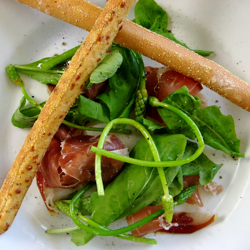 Once upon a time, there was a Chef who toiled away in other people’s kitchens. After gaining acclaim for a rare skill with classic preparations, the Chef moved to Napa Valley and opened a signature restaurant on the fringe of the sleepy village of Yountville.
Once upon a time, there was a Chef who toiled away in other people’s kitchens. After gaining acclaim for a rare skill with classic preparations, the Chef moved to Napa Valley and opened a signature restaurant on the fringe of the sleepy village of Yountville.
Soon, visitors flocked to the Valley not just to drink, but also to dine. An award-winning cookbook soon followed, then another cozier restaurant just down the road. The ensuing years brought more praise from the press, another cookbook, still more awards. Never content to rest on culinary laurels, the Chef recently opened a third restaurant aimed at a broader audience.
Think that you know this story? Not so fast. The hero of this particular tale is a woman, and the plot begins not in 1997 at The French Laundry with Thomas Keller, but in the dark ages of 1983 at a “truck stop deluxe” along Highway 29 known as Mustards Grill.
Before making history at Mustards, Cindy Pawlcyn made her name at the once-enthralling (but now sadly coasting) Fog City Diner. One of the first to popularize the conceit of comfort food as true cuisine, FCD was among the vanguard of New American restaurants. Pawlcyn was praised for her efforts there, and the cookbook she wrote remains a classic of the comfort-luxe genre.
When Pawlcyn took her jumped-up homespun specialties to Yountville, the national press knew she was onto something special. “[Mustards] changed Napa Valley and took the stuffiness out of dining,” said Gourmet magazine. Pawlcyn was soon in high demand, serving as chef and/or consultant to a string of well-known ventures, including San Francisco’s Bix, Marin’s Buckeye Roadhouse and Napa’s Tra Vigne. The Mustards Grill Napa Valley Cookbook won a James Beard Award, and it remains a perennial favorite in our kitchen (and many others, to judge from our friends’ bookshelves).
Pawlcyn eventually sold her share in the Real Restaurants empire to focus solely on Mustards, but with the 2001 takeover of St. Helena’s Miramonte, she again became a multi-location chef. Morphing into the less-threatening Cindy’s Backstreet Kitchen in 2003, this outpost continues to draw crowds — a happy success in a region where fickle diners often disappear as quickly as they came.
—-
We’ve eaten at most of Cindy Pawlcyn’s restaurants, including a good dozen visits to Mustards over the years, although a recent lunch there with family left me wondering if the 25-year-old landmark was feeling its age. The four of us ordered an assortment of options; none of our choices really wowed, and a few truly bombed. Months later, I grimace to recall a plate of greasy onion rings, and a pulled-pork sandwich with bland meat under a nearly inedibly sweet, heavily spiced sauce.
Happily, Pawlcyn’s two other ventures are as good as Mustards ever was in its prime.
We’ve returned to Cindy’s Backstreet Kitchen three times in as many trips north — twice last summer, and then once again last month. The food is old-school American with judicious flashes of Asian and Latin spark. If, like me, you’re a fan of Pawlcyn’s latest cookbook, Big Small Plates, you’ll find yourself equally taken with the dining room where many of its recipes first appeared. The decor evokes a gorgeous farmhouse, with a California crispness and vibrant splashes of Wine Country color. A long bar forms the centerpiece of the front dining room, a metaphor brought home by a clever cocktail list that weaves farm-fresh produce into a collection of delectable drinks.
In early 2007, Pawlcyn launched what is now her largest outpost: Go Fish. A “West Coast seafood house” along Highway 29, Go Fish is paradoxically cavernous but cozy, a coup that owes much to successful decor and lighting. The menu includes both traditional and modern seafood plates, but — as you might expect from a kitchen under the auspices of sushi master Ken Tominaga — the raw fish options are its stunning centerpiece. We visited over the holiday and out of a dozen nigiri and a few specialty rolls we sampled, only one (the kitchen’s very last portion of ikura, which we should have known better than to pounce upon) was less than sublime.
As lovely as Go Fish is, though, it’s too dear for everyday. It’s all too easy to spend hundreds of dollars on dinner for two, especially if you make a meal of the amazing sushi… which I highly suggest you do. Happily, there are many different ways to experience the inspired cuisine of the other — one might even say the original — Napa dining dynasty.
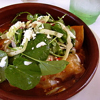
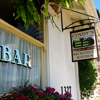

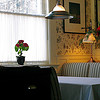
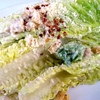
Cindy’s Backstreet Kitchen
1327 Railroad Avenue
St. Helena, CA 94574
707.963-1200
Go Fish
641 Main Street
St. Helena, CA 94574
707.963-0700
Mustards Grill
7399 St. Helena Highway
Yountville, CA 94558
707.944-2424
cookbooks, Napa & Sonoma, restaurants
5 Comments »




Posted by Cameron on 01.04.08 7:03 AM
 It sometimes seems like Dean & DeLuca‘s mission is to curate the world’s most eclectic collection of foodie curios. A trip through the aisles of the Napa Valley outpost can feel like a visit to Ripley’s Believe It Or Not! museum (“Oh look! Salt-cured hummingbird tongues packed in oil from Madagascar!”).
It sometimes seems like Dean & DeLuca‘s mission is to curate the world’s most eclectic collection of foodie curios. A trip through the aisles of the Napa Valley outpost can feel like a visit to Ripley’s Believe It Or Not! museum (“Oh look! Salt-cured hummingbird tongues packed in oil from Madagascar!”).
Of course, one of the great pleasures of cruising through such an outlandish assortment is that you occasionally run across something fabulous that’s incredibly difficult to find — like a bottle of Schweppes Indian Tonic Water. The regular Schweppes tonic is a staple in nearly every grocery store, but the drier Indian Tonic is all but unavailable in the States. Why the excitement? Until we sampled Fever Tree, I considered the rarely seen Schweppes Indian the sine qua non of tonic. Just as we grabbed a bottle from the cold case in order to see if was as good as we remembered, we spotted a 4-pack of Q Tonic, a newish brand that we’d heard of but not yet tried. Clearly the Fates had intervened, and another taste test was in order.
We set up the Schweppes Indian and the Q Tonic alongside a bottle of Fever Tree — the winner of our last tonic roundup — tasting each alone and mixed in a gin and tonic. Sweetened with glucose-fructose syrup and sugar, the Schweppes Indian tasted the most like the commercial American tonic waters, minus the nasty chemical aftertaste of high-fructose corn syrup. Its only drawback was a pronounced citrus finish that we found distracting. Next up, the Q Tonic had a light golden hue which may come from the agave syrup used as its sweetener. Bone dry, impossibly subtle, and with very little finish on the palate, the Q Tonic made for a somewhat flavorless G&T. If you’re tired of being bowled over by sugary, strongly-flavored tonic waters, you may enjoy the Q Tonic, but it left us unsatisfied.
Our favorite tonic remains the Fever Tree; we like the balance between bitter and sweet, the soft touch of cane sugar, and the occasional hints of spice.
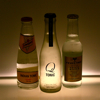
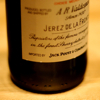



After revisiting the land of quinine, it seems only fitting to propose a tonic-based beverage for Drink of the Week. But since we’ve already covered the Gin & Tonic, and the Tequila & Tonic — and given that we refuse to consider Vodka-Tonic an actual drink — it seemed like we’d run out of options.
Luckily, CocktailDB rode to the rescue. The Granada seems like an oddball combination, but it’s surprisingly balanced and quite refreshing. Its relatively low alcohol content makes it a good option for cocktail parties, or perhaps a post-chores refresher on those Saturdays when a cold beer just seems too heavy or malty. It’s zippy and a little spicy, and the quinine’s bite cuts through the sweetness of the orange liqueur while playing off its bitter-orange notes to a T.
Granada
1 oz brandy
1 oz dry sherry
1/2 oz orange curaçao (such as Cointreau)
Shake together with ice, and strain into an ice-filled highball glass. Top with tonic, and serve.
Drink of the Week, drinks, recipes
6 Comments »




Posted by Anita on 01.03.08 8:17 PM
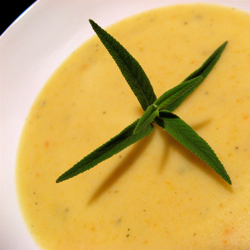 For us and for many of our friends, 2007 was a year of extremes and contradictions in our house and in our lives. I’ll spare you the maudlin, navel-gazing adjectives (oh, wait… shoot) and jump right into the highlight reel.
For us and for many of our friends, 2007 was a year of extremes and contradictions in our house and in our lives. I’ll spare you the maudlin, navel-gazing adjectives (oh, wait… shoot) and jump right into the highlight reel.
When January was just hours old, we rang in the new year with a streamlined version of our annual cassoulet. The next day, we invited you to tour our kitchens… yep, plural. The dysfunctional old one, the temporary kludge in the basement, and the yet-to-come remodeled dream. Later in the month, Cameron’s birthday was the impetus for the year’s most popular post: Boston Cream Pie cupcakes, which won the cupcake roundup for which they were created! Two other recipes created in the basement ‘camp kitchen’ — Fennel-Pear-Bleu salad and Golden Vegetable Bisque — turned into recurring winter favorites.
February was a slow month on the blog; we had some exciting progress on the kitchen remodel, then took a much needed hiatus to spend time with family after my dad passed away. Mom and I whipped up a batch of her justifiably famous banana bread, and Cameron cheered us up with a hopeful post about the promise of summer fruit from spring’s blossoms.
A March business trip turned up some pretty dismal dining experiences in the Big Apple, but the week was redeemed by fabulous cocktails at Pegu Club, among other worth establishments. Back on the home front: Can it have been nine whole months since we discovered our beloved Gialina? Our early crush has blossomed into a full-blown love affair with this solid, cozy Glen Park pizza bistro. By the end of the month, the kitchen wasn’t quite finished, but we’d moved back upstairs and started cooking. Our first meal: heritage-breed chicken, pasta with pan gravy, and broccolini.
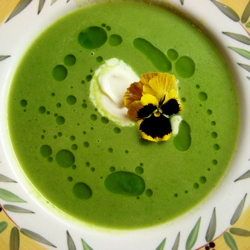 Not long after that, we hosted our first blog event: April’s edition of Mixology Monday featured all manner of Champagne cocktails… more than 16 in all. At Eastertime, Mom came to visit, and DPaul and Sean joined us for a traditional ham supper beginning with a stunning green-pea soup. Sam invited us all to show the world that English food is no joke, and Cameron responded with St. John’s roasted marrow bones and parsley salad from Nose to Tail. The end of April brought our first attempt at locavore eating, courtesy of the Penny-Wise Eat Local Challenge. Could we eat exclusively local food for a whole week on just $140? (Answer: Hell yes.)
Not long after that, we hosted our first blog event: April’s edition of Mixology Monday featured all manner of Champagne cocktails… more than 16 in all. At Eastertime, Mom came to visit, and DPaul and Sean joined us for a traditional ham supper beginning with a stunning green-pea soup. Sam invited us all to show the world that English food is no joke, and Cameron responded with St. John’s roasted marrow bones and parsley salad from Nose to Tail. The end of April brought our first attempt at locavore eating, courtesy of the Penny-Wise Eat Local Challenge. Could we eat exclusively local food for a whole week on just $140? (Answer: Hell yes.)
With May’s warmer weather, we started breaking out the tall, cool drinks. A tonic tasting was first on the list. (Stay tuned for an update with two new contenders). Speaking of drinks, we paid a visit to Seattle and made our first trip to Vessel, home of the inimitable Mr. Jamie Boudreau. Back home at the end of the month, I told you all about the pleasures of learning to cook Thai with Kasma.
 Come June, Cameron penned a fairy-tale ode to his favorite new/old restaurant, Two. We marked the 40th anniversary of Dorothy Parker’s demise with a round of classic Martinis. With the finishing touches in place, the kitchen remodel was finally ready for her closeup, Mr. DeMille. We headed up to Napa, new camera in tow, to pick walnuts for our annual batch of Nocino at Mr. Hoffman’s orchard. Rounding out the month, Cameron began his full-circle tour of the edible landscape in our backyard.
Come June, Cameron penned a fairy-tale ode to his favorite new/old restaurant, Two. We marked the 40th anniversary of Dorothy Parker’s demise with a round of classic Martinis. With the finishing touches in place, the kitchen remodel was finally ready for her closeup, Mr. DeMille. We headed up to Napa, new camera in tow, to pick walnuts for our annual batch of Nocino at Mr. Hoffman’s orchard. Rounding out the month, Cameron began his full-circle tour of the edible landscape in our backyard.
July in The City meant that summer was in full swing! Time to grind some beef for the season’s first backyard burgers. Sean taught us how to make perfect Mint Juleps, and we pitted pounds and pounds of fruit for homemade Maraschino cherries. We hosted four carnivorous friends for an afternoon of sausage-making mayhem, then wrapped up the month using our new ‘corn zipper’ to make a gorgeous summer souffle — a plate-licker of a dish if ever there was one.
In August, a young Cameron’s fancy turned to home-cured gravlax. We honored Mrs. Child with a supper of ham in piperade and souffle potatoes. Oh no we di-int make Piña Coladas! (Oh yes we did, and they rocked.) But sometimes you have a flop or two in the kitchen; we had a whole week of them, dammit. Thankfully, we were able to get some decent food into our bellies when we headed north to Cookie’s house to share a retro-style potluck with other Bay Area bloggers.
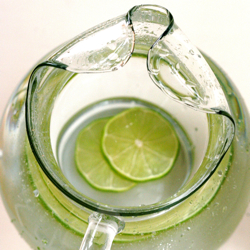 As the rest of the Bay Area blogoverse headed to Bi-Rite Creamery to celebrate September’s Indian summer, we snuck over to the Mission District’s other local treasure of an ice-cream shop, Mitchell’s. As always, there was plenty to drink at our house: An ode to our local Hetch-Hetchy water, a batch of homemade pear-infused brandy, and a cocktail in honor of Cameron’s favorite musical.
As the rest of the Bay Area blogoverse headed to Bi-Rite Creamery to celebrate September’s Indian summer, we snuck over to the Mission District’s other local treasure of an ice-cream shop, Mitchell’s. As always, there was plenty to drink at our house: An ode to our local Hetch-Hetchy water, a batch of homemade pear-infused brandy, and a cocktail in honor of Cameron’s favorite musical.
Some folks questioned our sanity, but yes, we really did can 100 pounds of Mariquita Farm tomatoes last October. Spending a couple of weeks at Mom’s meant lots of comfort food: a revamped Creole Rice Casserole, and our entry into National Meatloaf Day. Later in the month, we went public with our locavore status, plunging headlong into the Dark Days Challenge. A search for an all-local eats and drinks led us to an eerie tale of murder most fowl and my new favorite cocktail: Gin, honey, and lemon is indeed the Bee’s Knees.
November was obviously booze month: I won the inaugural edition of Raiders of the Lost Cocktail, and got to choose the next theme ingredient: Benedictine. We learned the truth about Mai Tais at Tiki-Ti, took our place behind the bar chez Hedonia, and won a “Does My Blog Look Good in This?” mention for… wait for it… a cocktail photo.
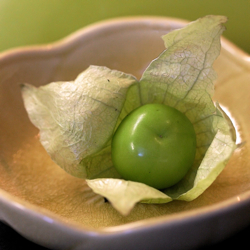 Which brings us barreling on home to December… what a month! After we shared our favorite way to gobble up turkey leftovers (that’d be Enchiladas suizas), we bellied up to the bar for a sweet vermouth tasting, and spent seven straight nights eating locally sourced suppers. While preoccupied with Menu for Hope, were stunned to be nominated for Best Blog Covering Drinks — we never expected to win! (Thank you all, again. Wow.)
Which brings us barreling on home to December… what a month! After we shared our favorite way to gobble up turkey leftovers (that’d be Enchiladas suizas), we bellied up to the bar for a sweet vermouth tasting, and spent seven straight nights eating locally sourced suppers. While preoccupied with Menu for Hope, were stunned to be nominated for Best Blog Covering Drinks — we never expected to win! (Thank you all, again. Wow.)
So yeah… highest highs, lowest lows, and all the what-have-you in between. I wouldn’t repeat this year for love or money, but I can’t say it wasn’t without its memorable occasions. I know it seems trite to say we couldn’t have done it without you, but it’s true — we’re truly blessed to have so many passionate subscribers, thoughtful commenters, and fabulous foodie friends.
I hope 2008 brings you everything you want, both in and out of the kitchen.
other stuff
8 Comments »




Posted by Anita on 12.28.07 7:03 AM
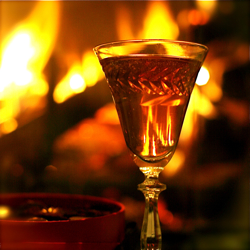 As 2007 slips away, our thoughts turn to cocktails we’d want to sip while curled up on the sofa with a good book or a fascinating companion. To my mind, the best drinks for the shortest nights mix spicy holiday flavors with a dash of new year’s sparkle.
As 2007 slips away, our thoughts turn to cocktails we’d want to sip while curled up on the sofa with a good book or a fascinating companion. To my mind, the best drinks for the shortest nights mix spicy holiday flavors with a dash of new year’s sparkle.
We wanted to pair these classic year-end tastes with seasonal citrus, given the incredible varieties gracing our farmers market. Initially, we tried blood-orange juice, elderflower liqueur, and Champagne, but we weren’t happy with the look — it screamed “Jello shot” rather than whispering “cocktail”. When we tried less garishly colored juices, our sparkler felt more like a complicated Mimosa than a cozy evening tipple.
Spying a small bottle of the Charbay Ruby Red grapefruit vodka in a pricey St. Helena liquor emporium, we decided to try a different route to the citrus belt. (Are you turning up your nose at flavored vodka? Don’t. These folks mean business: They use real fruit and old-world recipes. And they’re local. To us, anyway.) The vodka’s grapefruit-peel bitterness tempers the floral sweetness of the liqueur; the bubbly brightens the drink, while Fee’s whiskey-barrel bitters add a masculine depth.
Speaking of the Fee’s: If Santa didn’t leave you a bottle of these delectable drops in your stocking, you need to correct this error yourself. Yes, they’re worth the shocking premium over the cost of regular bitters, and you might have to break down and pay for shipping. If you have to go the mail-order route, you may as well buy a few bottles for friends. No, really… you can thank me later.
A finishing touch of orange bitters reinforces the drink’s citrus-spice scent, without adding any untoward sour or sweet notes. Of course, you can make this cocktail with any sparkling wine — a lovely trait during the time of year when half-finished bottles of bubbly seem to magically appear in fridges everywhere. But for that perfect flame-like glow, seek out a dryish rosé for your sparkler… and get ready to get cozy.
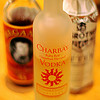
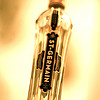


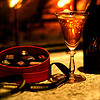
Firelight
1 oz St-Germain elderflower liqueur
1/2 oz grapefruit-infused vodka, homemade or Charbay Ruby Red
3 dashes Fee’s whiskey barrel bitters (or 2 dashes Angostura and 1 dash Peychaud’s)
—
2 oz rosé sparkling wine
1 to 2 dashes orange bitters (preferrably Regan’s)
In a mixing glass with ice, stir together the St-Germain, grapefruit vodka, and aromatic bitters. Strain into a chilled cocktail glass, and top with the bubbly and the orange bitters.
Drink of the Week, drinks, holidays & occasions, recipes
8 Comments »




Posted by Anita on 12.26.07 12:45 PM
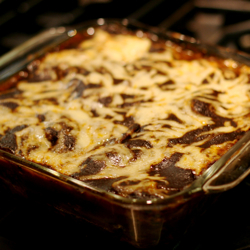 Getting the house — and the fridge — ready for our 10-day Christmas absence was an enormous pain in the ass. Truthfully, I enjoy the puzzle of combining fresh food and freezer fodder to make reasonably coherent meals, but sometimes this happens at the expense of our 90%-local Dark Days Challenge goal.
Getting the house — and the fridge — ready for our 10-day Christmas absence was an enormous pain in the ass. Truthfully, I enjoy the puzzle of combining fresh food and freezer fodder to make reasonably coherent meals, but sometimes this happens at the expense of our 90%-local Dark Days Challenge goal.
A case in point: We needed to use up tortillas (local), beans (ditto) and salsa (yep), plus an assortment of cheeses (likewise) — a natural set of ingredients for BudÃn Azteca, a.k.a. tortilla pie. So we defrosted the last of the local Thanksgiving turkey… and a decidedly non-local batch of mole sauce. We could say that the chiles qualify as seasonings and the chocolate’s a baking supply — both of which are exempt from the challenge. But given that we made and froze this sauce early last spring, long before even our first stab at locavorism, that seems a bit far-fetched.
 Our second attempt was less of a stretch. With a half-jar of home-canned tomatoes, a few strips of Fatted Calf pancetta, half a ball of Belfiore mozzarella, and a handful of Far West mushrooms, we had all the makings of a couple of pizzas. We’ll overlook that the frozen pizza dough was made months ago with non-local flour (it’s still an exemption, after all, even if we have found some local sources for grains). Add a salad of Star Route Farms romaine, radicchio, and radishes, and we could call this our first true 90% meal of the week.
Our second attempt was less of a stretch. With a half-jar of home-canned tomatoes, a few strips of Fatted Calf pancetta, half a ball of Belfiore mozzarella, and a handful of Far West mushrooms, we had all the makings of a couple of pizzas. We’ll overlook that the frozen pizza dough was made months ago with non-local flour (it’s still an exemption, after all, even if we have found some local sources for grains). Add a salad of Star Route Farms romaine, radicchio, and radishes, and we could call this our first true 90% meal of the week.
Hitting the mark without a single cheat, Tuesday night’s steak dinner featured Prather Ranch ribeye, an assortment of stray Little’s potatoes mashed with Straus cream and Clover butter, and another big salad, this one dressed with Point Reyes Blue and Bariani olive oil. Yum. Friday’s pasta night was another clean sweep: Our usual Bolognese sauce over Eduardo’s, a carrot-and-radish-topped salad, and garlic toast made from the heels of our Acme pain de mie loaf.
All in all, not a bad week of local eating, given everything else that we had going on.
It’s been a while since we’ve added any new local products to our pantry, but we discovered not just one variety but a whole assortment of dried chiles at the Tierra Vegetables stand at the Ferry Plaza market. Maybe, just maybe, the next time we pop a package of mole out of the freezer, we won’t be fudging at all.
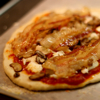
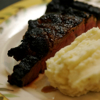

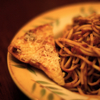
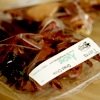
BudÃn Azteca
1 to 2 cups shredded chicken or turkey
1/2 to 1 cup prepared salsa
6 to 8 corn tortillas
2 cups mashed black or pinto beans
2 cups mole (recipe follows)
1/2 cup chicken stock, plus more as needed
2 cups shredded melting cheese, such as Jack or mozzarella
sour cream, sliced radishes, and cilantro for garnish
Preheat oven to 350°F.
In a saucepan, warm the beans over medium-low heat, thinning with chicken stock or water to a spreadable consistency.
In a separate pan, warm the meat with the salsa.
In a third pan, heat the molé, thinning with 1/2 cup or more of chicken stock, to a tomato-sauce consistency.
Heat the tortillas in a skillet or over an open flame. Cut each tortilla into quarters and keep warm, wrapped in a clean dishtowel until ready to use.
Set aside 3/4 cup of the mole sauce for later use. Spread a spoonful of the remaining thinned sauce on the bottom of a 9×9 pan. Layer 6 to 8 tortilla quarters on top of the sauce, followed by 1/3 of the beans, 1/3 of the meat, a quarter of the cheese, and another small drizzle of the sauce. Repeat layering until all of the beans and meat have been used. Top the stack with the reserved 3/4 cup of sauce and the last quarter of cheese.
Bake, uncovered, 30 to 45 minutes, or until the sauce is bubbly and the casserole is warmed through to the center. If the cheese browns before the center of the pie is heated, cover with foil to prevent overbrowning. (Do not cover before this stage, or you will end up with cheese stuck to the foil.)
Let the casserole sit 5 minutes before cutting. Serve with a green salad on the side, and your choice of garnishes.
—–
Mole de la Suegra
– adapted from Big Small Plates
2oz dried chiles negros
2oz dried chiles anchos
1/4 cup sesame seeds
1T whole black peppercorns
6 whole cloves
5 to 6 T lard or oil
2 slices french bread
1 large tomato, halved
1 large onion, cut into 4 thick slices
1 large clove garlic
2T salt
4 cups chicken broth
1 disk Mexican chocolate, coarsely chopped
Stem and seed the chiles, reserving the seeds in a small bowl, then gently toast the chiles in a skillet over medium heat just until soft; a couple of wisps of smoke are okay, but do not let them burn or your sauce will be bitter. Cover the toasted chiles with warm water and set aside.
Over high heat, toast the chile seeds lightly, continuously shaking the pan for 30 to 60 seconds. Return the seeds to their bowl. Toast the sesame seeds until lightly golden. Place them in the bowl with the chile seeds and let cool to room temperature. When sesame and chile seeds have cooled, grind them together with the cloves and peppercorns in a coffee grinder.
Put a large bowl next to the stove. In the skillet over medium heat, heat 2T of the lard until it shimmers. When fully heated, fry the bread until golden on both sides. Place the fried bread in the bowl. If needed, add another tablespoon of lard to the pan and caramelize the tomato, 5 to 7 minutes. When heated through and well browned, scoop the tomato into the bowl with the bread. Add more lard, if needed, and caramelize the onion slices and garlic, adding them to the bowl when well browned (7 to 10 minutes).
Drain the chiles, reserving the soaking liquid, and add them to the bowl. Add the ground seeds and spices and 2T salt to the bowl, and puree with a stick blender until smooth. (Alternately, you can blend in 2 to 3 batches in a conventional blender.) Add enough of the chile-soaking water to the puree to achieve a pourable consistency.
In a heavy saucepan over high heat, warm the rest of the lard. Before the fat smokes, carefully pour the sauce into the pan and fry for 1 to 2 minutes, stirring constantly. Reduce the heat and add the broth; simmer 10 minutes. Add the chocolate and simmer an additional 30 to 45 minutes. Use immediately, or cool to room temperature before storing.
Note: Unlike chicken stock or pasta sauce, we don’t freeze mole directly in quart-size bags. Like other oily sauces — curry pastes, pesto, etc. — we chill and freeze it in 1- and 2-cup plastic storage containers. When fully frozen, the sauce pops out of the containers and can be placed in vacuum-seal or Ziploc bags for longer storage. Be sure to remove the puck of sauce from the bag before thawing, to keep sauce from sticking to the inside of the bag.
locavore, Mexican, recipes
4 Comments »




Posted by Anita on 12.24.07 8:54 PM
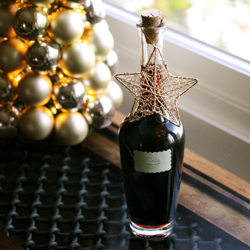 We hope your holiday — whichever one you celebrate — is brimming with cheer, and your new year will be filled wonderful things to eat and drink.
We hope your holiday — whichever one you celebrate — is brimming with cheer, and your new year will be filled wonderful things to eat and drink.
Thank you for stopping by, subscribing, and supporting us.
And thank you, too, for supporting Menu for Hope. With your generosity, we’ve raised more than $90,000 for the UN World Food Programme — more than half as much as last year.
We couldn’t have done it without you.
holidays & occasions, Menu for Hope
2 Comments »




Posted by Anita on 12.21.07 12:01 PM
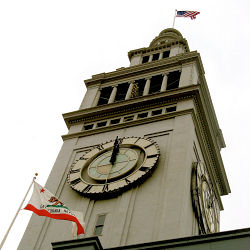 Time is running out on your chance to win some splendid prizes in this year’s Menu For Hope raffle. Have you placed your bids yet? If not, you may want to check out Pim’s handy list of good bets.
Time is running out on your chance to win some splendid prizes in this year’s Menu For Hope raffle. Have you placed your bids yet? If not, you may want to check out Pim’s handy list of good bets.
You’ll notice that your chances are still reasonably good to win our Custom Mixology Service, better known as prize code UW08. If you should doubt our cocktail prowess — and who could blame you for wondering whether our blogging chops translate to real-world results? — check this first-hand account of our mad mixmaster skillz at Sean’s birthday party. And honey, as much as the Hedonia boys love us, they wouldn’t tell you something tasted good if it sucked.
No love for our Cocktail Notecards? Shocking, I say. But hey, I’m a big girl. Besides, I’ve made my peace with this little drama in a rather selfish way: The cards arrived from Moo last week, and they’re so damned cute and professional-looking that I’m secretly hoping that nobody would win them and I can keep them for myself.
But that’s not very generous, is it? [Sigh.]
Taking a page from Sam’s brilliant bribery, I’m adding a incentive to this prize. Bid on the photocards — that’s prize code UW07 — any time after noon today, then leave me a comment here with the name you bid under. If you’re the winning bidder and you’ve commented on this post before the prize drawing happens, I’ll include your choice of an 8×8 or 8×10 print of any of our cocktail or food photos.
And in case that wasn’t sufficient incentive to bid, check out this fabulous offer from food writer Rebekah Denn’s new Devouring sEATtle blog: If you’re one of the first five folks to forward your Menu for Hope donation conformation to Rebekah, she’ll send you a cookbook from her stash. How’s that for a win-win?
But you’d better get a wiggle on: The raffle closes tonight at midnight Monday at 9am Eastern time.
Go… Bid. And don’t say we didn’t make it tempting.
Menu for Hope
3 Comments »




Posted by Anita on 12.21.07 7:02 AM
 It seems like ages ago that we chose Benedictine as the theme for the second edition of Raiders of the Lost Cocktail over on The Spirit World. As November wound down, tasty-sounding cocktails popped up in the comments section, and we all held our breath waiting for the judges to pronounce a winner. The silence was deafening.
It seems like ages ago that we chose Benedictine as the theme for the second edition of Raiders of the Lost Cocktail over on The Spirit World. As November wound down, tasty-sounding cocktails popped up in the comments section, and we all held our breath waiting for the judges to pronounce a winner. The silence was deafening.
About a week ago, I got an email from Andrew, The Spirit World’s intrepid editor, asking me when I’d be able to send him my choice for RotLC winner.
Come again?
Never mind that the previous episodes’ rules had clearly stated “The winner will be chosen by consensus judgment of the TSW staff”. Andrew made it plain that the Powers That Be would not take no for an answer. I was duly deputized to act as their collective liver brain in matters Benedictine.
People, if you think that it was tough for me to choose a mixable yet somewhat obscure spirit, you have no idea how hard it was to pick the winning drink from a batch submitted by friends and colleagues!
But duty called. I printed out a list of recipes — leaving off the names of their contributors — and gathered a double armload of ingredients from the bar. Some promising drinks were doomed from the start, being previously unpublished recipes, or personal variations of classics. Remember, dear reader, the purpose of Raiders is resurrecting the cocktails of yore, finding them a new audience among the modern mixology mavens.
And then there were more than a few that fell outside the bounds of “relatively common ingredients” and “simpler construction”. (Does your neighborhood tavern stock creme de roses? Raspberry syrup? Whole eggs? Mmm, yeah… mine either.)
Even after winnowing the wheat from the chaff, we were left with a healthy roster of candidates. We shook, we stirred, we sipped, we shot. We tasted and tested, and resisted the temptation to tweak. When all was said and done, two drinks rose to the top of the pack, and we set those recipes aside for a second night of testing on fresh palates.
The first, Tango No. 2, was dead simple: Equal parts dry and sweet vermouth, Benedictine, white rum, and orange juice. No complicated garnish, no funky glassware, no special equipment. The combination of rum and OJ brought out the Benedictine’s citrus notes, and the two vermouths played well with its herbal components. A well-balanced drink and a serious contender.
But the drink that won our hearts — the one we both tried to sneak away with when judging was done — was the Cocktail a la Louisiane. The lovechild of the creole Sazerac and the yankee Manhattan, the Louisiane’s gorgeous glow warms a jaded soul. We worried a few moments about the “preference to common ingredients” clause, as La Louisiane is best with absinthe. But we rationalized that the bottle of pastis you’re likely to find in most big-city bars is sufficient to make this old New Orleans gem shine brightly.
So, ladies and gents, a round of applause for Paul Clarke of The Cocktail Chronicles, the promoter of this fair libation, and the lucky fellow who’ll pick next month’s signature ingredient.





Cocktail a la Louisiane
— from Stanley Clisby Arthur’s Famous New Orleans Drinks and How to Mix ‘Em
3/4 ounce rye
3/4 ounce Benedictine
3/4 ounce sweet vermouth
3 dashes Peychaud’s bitters
3 dashes absinthe, Herbsaint, or pastis
Stir all ingredients in an ice-filled mixing glass. Strain into a well-chilled cocktail glass, garnish with a cherry.
Mixing note: It’s simple to measure three dashes of bitters — they come in a shaker-top bottle, after all. The absinthe’s a bit trickier, and even a slightly heavy hand will throw your drink off balance. To keep the anise in line, we shook the bitters into a bar spoon to get a rough idea of what “three dashes” looked like, then measured an equal amount of absinthe. If you find yourself smitten enough to adopt the Louisiane as your winter tipple, fill an empty bitters bottle with absinthe to keep the ritual simple.
Drink of the Week, drinks, other blogs, recipes
2 Comments »




 Oh, boy! The winners of the Menu for Hope raffle have been announced. Check out Pim’s giant list of all the winners to see what you won.
Oh, boy! The winners of the Menu for Hope raffle have been announced. Check out Pim’s giant list of all the winners to see what you won.























 For us and for many of our friends, 2007 was a year of extremes and contradictions in our house and in our lives. I’ll spare you the maudlin, navel-gazing adjectives (oh, wait… shoot) and jump right into the highlight reel.
For us and for many of our friends, 2007 was a year of extremes and contradictions in our house and in our lives. I’ll spare you the maudlin, navel-gazing adjectives (oh, wait… shoot) and jump right into the highlight reel. Not long after that, we hosted our first blog event: April’s edition of Mixology Monday featured all manner of
Not long after that, we hosted our first blog event: April’s edition of Mixology Monday featured all manner of  Come June, Cameron penned a fairy-tale ode to his favorite new/old restaurant,
Come June, Cameron penned a fairy-tale ode to his favorite new/old restaurant,  As the rest of the Bay Area blogoverse headed to Bi-Rite Creamery to celebrate September’s Indian summer, we snuck over to the Mission District’s other local treasure of an ice-cream shop,
As the rest of the Bay Area blogoverse headed to Bi-Rite Creamery to celebrate September’s Indian summer, we snuck over to the Mission District’s other local treasure of an ice-cream shop,  Which brings us barreling on home to December… what a month! After we shared our favorite way to gobble up turkey leftovers (that’d be
Which brings us barreling on home to December… what a month! After we shared our favorite way to gobble up turkey leftovers (that’d be 





 Getting the house — and the fridge — ready for our 10-day Christmas absence was an enormous pain in the ass. Truthfully, I enjoy the puzzle of combining fresh food and freezer fodder to make reasonably coherent meals, but sometimes this happens at the expense of our 90%-local
Getting the house — and the fridge — ready for our 10-day Christmas absence was an enormous pain in the ass. Truthfully, I enjoy the puzzle of combining fresh food and freezer fodder to make reasonably coherent meals, but sometimes this happens at the expense of our 90%-local 





 We hope your holiday — whichever one you celebrate — is brimming with cheer, and your new year will be filled wonderful things to eat and drink.
We hope your holiday — whichever one you celebrate — is brimming with cheer, and your new year will be filled wonderful things to eat and drink. Time is running out on your chance to win some splendid prizes in this year’s
Time is running out on your chance to win some splendid prizes in this year’s 





